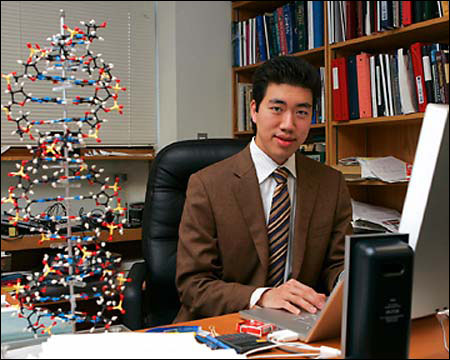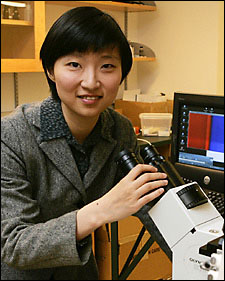Howard Hughes Medical Institute investigators named
Chemists Liu and Zhuang bring to 13 Harvard’s current ranks of prestigious HHMI researchers

Chemists David R. Liu and Xiaowei Zhuang of Harvard University’s Faculty of Arts and Sciences are among 43 young researchers nationwide named new investigators of the Howard Hughes Medical Institute Monday (March 21). HHMI will collaborate with Harvard to fund the new investigators’ research for the next five years, with the possibility for funding renewal in 2010.

Liu and Zhuang, both of Harvard’s Department of Chemistry and Chemical Biology, will join 11 other Harvard scientists already receiving research support from HHMI’s prestigious investigator program. HHMI’s 298 investigators nationwide are widely recognized for their creativity and productivity: More than 100 are members of the National Academy of Sciences and 10 have been honored with the Nobel Prize.
“I am pleased that this great honor has been accorded to these highly imaginative and intellectually daring scientists,” said William C. Kirby, Edith and Benjamin Geisinger Professor of History and dean of the Faculty of Arts and Sciences. “Both David and Xiaowei are exceptionally talented and dedicated colleagues who, in the early stages of their careers, have already made remarkable research contributions. I am grateful to HHMI for nurturing their careers.”
Liu, 31, professor of chemistry and chemical biology, joined the Harvard faculty in 1999; Zhuang, 33, assistant professor of chemistry and chemical biology and of physics, joined Harvard in 2001.
David R. Liu
Liu harnesses biomolecules such as DNA to guide synthesis of compounds to study chemical reactions and the machinery of life. Recognizing that evolution has created far more efficient, selective, and sensitive ways to synthesize molecules than has been accomplished in laboratories, Liu’s research is guided by the belief that nature’s synthetic ingenuity can provide scientists with important insights into chemistry and biology.
Liu uses the natural tendency of nucleotides to selectively attach to one another to guide the synthesis of complex molecules, and has found this DNA-templated organic synthesis to be surprisingly general, capable of directing a range of chemical reactions. Nucleotides on one strand of DNA zip together with those on another; Liu uses this complementarity to guide chemical synthesis by attaching precursors of desired molecules to specific DNA sequences. This natural pairing of their associated DNA strands causes the precursors to undergo chemical reactions to form a desired molecule.
Liu has generated diverse libraries of small molecules by using DNA-templated synthesis in the multistep creation of a range of complex organic small molecules and organic polymers. He is mining these molecular libraries using powerful evolution-based “selections” to find small molecules with desired biological properties, to synthesize new types of polymers, and to discover new bond-forming chemical reactions. He is using related techniques to “evolve” functional biological macromolecules, such as proteins and RNAs, to probe the mechanisms of biological systems.
Recipient of a B.A. from Harvard College and a Ph.D. from the University of California, Berkeley, Liu was a 2004 Popular Science “Brilliant 10” young scientist and was named to the MIT Technology Review TR100 as “one of the world’s top young innovators.” He has also received the American Chemical Society’s Arthur C. Cope Young Scholar Award.
Xiaowei Zhuang
Zhuang is employing a range of techniques to visualize single biological molecules and particles to reveal how viruses infect cells and how RNA molecules function as catalysts. She studies the action of individual molecules, using ultrasensitive optical imaging to take “movies” of single molecules and other particles involved in biological processes in real time. Combining this approach with other analytic techniques allows her to investigate the mechanisms underlying intricate biological processes.
By tagging viruses with fluorescent molecules that emit specific colors of light, Zhuang has caught viruses in the act of entering a cell. Visualizing this process allows her to analyze the steps involved in various viral infections. This approach promises to identify targets for new antiviral drugs in the future. She has also traced the entry into cells of polymers engineered to deliver genes a method of gene therapy for diseases like cystic fibrosis, Parkinson’s disease, and certain cancers that scientists hope will be safer and allow better control than viral vectors.
Zhuang’s single-molecule visualization techniques also allow her to study the folding, assembly, and function of RNA enzymes that catalyze several essential biological processes. Using techniques such as fluorescence resonance energy transfer, which traces the transfer of energy between “donor” and “acceptor” fluorescent tags on different parts of a molecule, Zhuang has captured the dynamic structures of RNA enzymes and RNA-protein complexes.
Zhuang received her B.S. from the University of Science and Technology of China, and her M.S. and Ph.D. from the University of California at Berkeley. In 2003, she received a MacArthur Fellowship, popularly known as the “genius grant.” She has also been named “one of the world’s top young innovators” by the MIT Technology Review TR100, a Packard Fellow for Science and Engineering, and an Alfred P. Sloan Research Fellow.
Established in 1953 by the aviator-industrialist, the Chevy Chase, Md.-based Howard Hughes Medical Institute is dedicated to discovering and disseminating new knowledge in the basic life sciences. With an endowment of roughly $12.8 billion, HHMI is one of the largest philanthropies in the world, spending $573 million in support of biomedical research and $80 million for support of a variety of science education and other grants programs in fiscal 2004.




